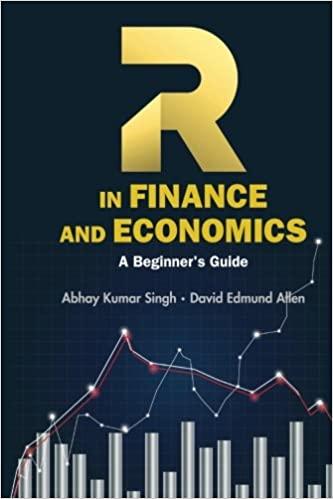Question
Bobbys REIT has risky commercial properties and less risky apartment properties The commercial properties are unique, and Bobby is not sure what the risk and
Bobbys REIT has risky commercial properties and less risky apartment properties
The commercial properties are unique, and Bobby is not sure what the risk and required rate of return on those businesses might be. REITS pay no entity level tax. In fact, simply assume there are no taxes.
His total firm market value is $6 billion = $6,000 million (all equity)
The publicly traded stock has an estimated beta = 1. The firm has NO debt.
His apartment business is believed to have an unlevered beta, bu = .75
The risk-free rate, rRF = 3% and the market risk premium, RPM = 5%.
The apartment business expected cash flow annually is $190 million for the upcoming year growing in perpetuity at 2% a year.
Assume the market has correctly price the pieces of the real estate business so that the sum of the two businesses market value = $6,000m and that required returns on stocks conform to CAPM. Note these are growing perpetuities, not flat. We might expect some natural inflation growth in these businesses due to inflation (okay view this as a good assumption a few years back!).
- What is the required return and value of the apartment business?
- Assume Bobbys stock is fairly priced. The stocks publicly traded stock beta is 1. What is the required return on the commercial property business that we can infer from the above information? (Hint: the combined division values make up the value of the stock and the stock has a beta of 1. The market value weighted average of the betas of each unit should equal the beta of the stock. If you know the apartment unit market value and the company stock value, you can infer the commercial property unit value.)
- If the firm got the opportunity to buy an additional commercial property business that costs $100m today and would generate annual cash flow of $8.1m at the end of the year with the propertys cash flows growing at 2% a year in perpetuity, what would be the NPV of the project and should the firm take the project assuming new shares of stock can be sold to finance the acquisition on fair terms (fair means shares sold for what they are worth)?
- In a perfect market setting, instead of financing with equity, if the firm were to debt finance the acquisition with a small, risk free $100 million debt issue with a required return of 3%, would it change your answer in c). Briefly explain why or why not?
Step by Step Solution
There are 3 Steps involved in it
Step: 1

Get Instant Access to Expert-Tailored Solutions
See step-by-step solutions with expert insights and AI powered tools for academic success
Step: 2

Step: 3

Ace Your Homework with AI
Get the answers you need in no time with our AI-driven, step-by-step assistance
Get Started


